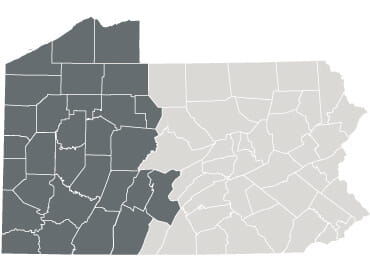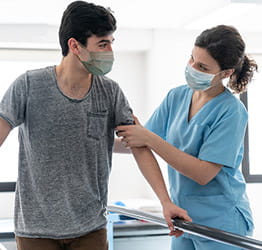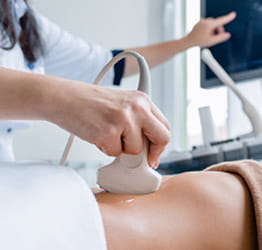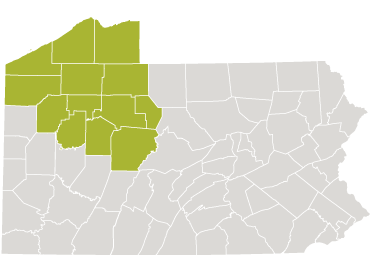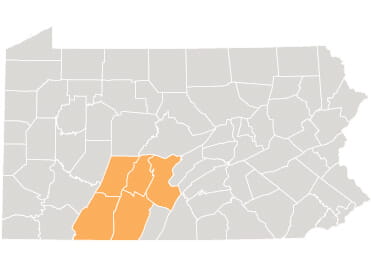AID MI Study
PI: Samir Saba, MD
Research Coordinator: Eric Pasquantonio
The purpose of this research study is to determine and understand the clinical outcomes in patients following an AMI with cardiac monitoring using the Confirm RX Insertable Cardiac Monitor or Abbott equivalent commercially available insertable cardiac monitor. Your involvement in the trial will be for two years following randomization and the trial will enroll approximately 200 patients.
- Looking for patients 18 years or older that have experienced AMI (STEMI and NSTEMI) and are expecting hospital discharge within 7 days of AMI. The patient must be willing to give written informed consent and receive ICM insertion within 21 days of index AMI.
- Follow-up will be done at 30 days, 90 days, 12 months, and 24 months after enrollment. All follow-up visits could be performed remotely by phone call and remote device interrogation (if applicable) or in person at the outpatient clinic.
- Questionnaires and surveys will be completed by the patient during the follow-up period.
- There will be two treatment groups randomly assigned. 100 patients will be assigned to a control group (no device) and the other 100 patients will be assigned to receive the Insertable Cardiac Monitor.
- Expanding enrollment to our UPMC Hamot campus; will expand to Altoona eventually.
Reach out to Eric, RN at 412-647-8210 or pasquantonioej@upmc.edu, or Jessica Caratelli at 412-246-5997 or daughtersj@upmc.edu for more details.
Catalyst
PI: Samir Saba, MD
Research Coordinator: Susan Sweeny
The CATALYST Trial is studying the Amplatzer™ Amulet™ Left Atrial Appendage Occluder in patients with non-valvular atrial fibrillation who are either on a non-vitamin K antagonist oral anticoagulant (NOAC) blood thinner, or eligible to take a NOAC.
WHO CAN PARTICIPATE IN THE CATALYST TRIAL COMPARING LEFT ATRIAL APPENDAGE OCCLUSION TO NOAC THERAPY? Both men and women can participate.
You may qualify if:
- You have been diagnosed with non-valvular atrial fibrillation and are at an increased risk for ischemic stroke
- You have a CHA2DS-VASc score of 2 or greater in males, and 3 or greater in females
- Your doctor believes you are eligible for NOAC therapy
- You are willing and able to complete the study follow-up visits
- You are willing to receive an Amulet Left Atrial Appendage Occluder if randomized to that therapy
Please reach out to Susan Sweeny, RN, for details at 412-864-1420 or sweenysm@upmc.edu.
LAAOS-4
PI: Sandeep Jain, MD
Research Coordinator: Eric Pasquantonio
You are being invited to take part in a research study called The Fourth Left Atrial Appendage Occlusion Study: (LAAOS-4). Taking part in this study is completely voluntary. The purpose of the LAAOS-4 study is to determine if closure of the left atrial appendage using a closure device called the WATCHMAN™, in addition to taking oral anticoagulant medications, is more effective at reducing strokes and blood clots in your body, than taking oral anticoagulant medications on their own.
Please reach out to Eric Pasquantonio, RN at 412-647-8210 or pasquantonioej@upmc.edu.
Left vs. Left RCT
PI: Krishna Kancharla, MD
Research Coordinator: Sherry Pellegrino
You are being invited to take part in this research study because you have a weak heart (heart failure). The electrical system of your heart muscle has many tiny cells that form a tree-like shape with small branches that run throughout the lower chambers of your heart. Your heart’s electrical system controls the timing of your heartbeat (by sending out electrical signals) and conducts electricity very fast through these tiny cells. We know that people with a weak heart and an abnormal heart beat can benefit from having a pacemaker.
If you decide to take part in this study, you will be randomly assigned (like flipping a coin) to one of two treatments (A or B), both of which are standard of care heart pacing treatments:
- A. Pacing your heart from two locations in the left ventricle (lower left chamber of the heart)
- B. Pacing your heart from one of two other places in the heart (the “His” or the left bundle branch) which are parts of the normal electrical system
The purpose of this study is to compare side by side these two treatments and evaluate if one is better than the other. This study is under the oversight of the Food and Drug Administration (FDA) which means only devices and leads covered under their oversight will be used.
Please reach out to Sherry Pellegrino, RN, for details at 412-647-8437 or pellegrinosl@upmc.edu.
PIVATAL
PI: Krishna Kancharla, MD; David Kaczorowski, MD
Research Coordinator: Rachel Mcgargle; Susan Sweeny
Looking for patients with advanced cardiomyopathy (INTERMACS classification) and eligible for LVAD per HF clinical team who have had ICD w/remote monitoring in past and sustained VT or VF episode (>30 seconds in duration) in the past 5 years.
Reach out to Rachel, RN 412-864-0788, mcgarglerd@upmc.edu; or Susan, RN 412-864-1420, sweenysm@upmc.edu for more information.
PVC Imaging
PI: Sandeep Jain, MD
Research Coordinator: Susan Sweeny
The research study is being conducted to evaluate if imaging techniques can identify irregular heart rhythms with extra heart beats (PVCs) that would cause a cardiomyopathy.
The purpose of this study is to find out if we can determine if certain extra heart beats are bad for the heart and could cause the heart function to decline.
You are being invited to participate in a research study because you have an irregular heart rhythm with extra heart beats (PVCs).We are looking for patients with > or = 9.5% PVC’s who are likely to undergo PVC ablation and/or medical suppression of PVC’s.
If you have any potential candidates for the study, please contact Susan Sweeny, RN, at 412-864-1420 or sweenysm@upmc.edu

